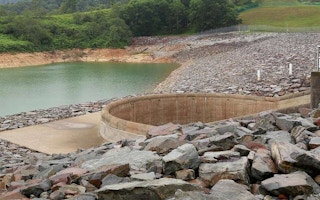The Singapore government expressed concern on Monday over the ‘unprecedented’ decline in water levels of a major reservoir located at the Johor River in neighbouring Malaysia, a major source of water.
Vivian Balakrishnan, Singapore’s minister for the environment and water resources, said the prolonged dry weather conditions from last year has affected the Linggiu Reservoir, whose water level has dropped to a historic low of 54.5 per cent of its capacity.
“This is a regulating reservoir that releases water to reduce seawater intrusion into Johor River. It is the key to ensuring the river can provide 250 million gallons per day for us,” said Balakrishnan in a post from his Facebook page.
The Johor River, Singapore’s source of imported water, supplies up to 60 per cent of Singapore’s daily water needs.
“
No other country has pursued water security with such a single minded focus on such a scale. Without these investments we would be in a very precarious position.
Vivian Balakrishnan, Singapore’s minister for the environment and water resources
Singapore is able to access water from Johor as part of a 1962 water agreement with Malaysia, which will end in 2061. The city-state finished building the reservoir in 1995 and now runs it, but it is owned by the state of Johor.
Balakrishnan urged citizens to be concerned and conserve water as the probable onset of the El Nino phenomenon this year could compromise the city-state’s biggest water source, but he added that the current situation should not be cause for alarm.
The Australian weather bureau reported on Tuesday that El Nino, a weather pattern that’s leading to the warming of the surface of the Pacific, has now been established and will continue to strengthen. This weather pattern could persist until early 2016, it warned.
The minister noted that Singapore’s local reservoirs “may look full” only because the government-run water agency PUB has been operating the country’s desalination and water treatment plants at “almost full capacity”.
“We are grateful for the additional safety margin that these desalination and NEWater plants have given us. In 12 years, we increased our capacity from desalination and NEWater from 0 per cent to 55 per cent of our water needs today,” Balakrishnan noted on his social media post.
NEWater is Singapore’s branded water that has been recycled using advanced water treatment technologies.
The government has been investing in water technologies to meet the country’s growing demand for water. PUB announced last year that a fifth water recycling plant is under construction and will be ready by 2016. A third desalination plant is also on course to operate by 2017.
Water scarcity has been the island-nation’s dilemma since its independence from Malaysia 50 years ago, but the country’s leadership under former prime minister Lee Kuan Yew has paid much attention to addressing the problem through water sustainability initiatives.
“No other country has pursued water security with such a single minded focus on such a scale. Without these investments we would be in a very precarious position,” stressed Balakrishnan.
However, he also pointed out that even as the country’s water system is in a “much stronger and secure position now”, it should not be taken for granted.
“We have to constantly be aware of potential problems and prepare well ahead of time,” he said.

















